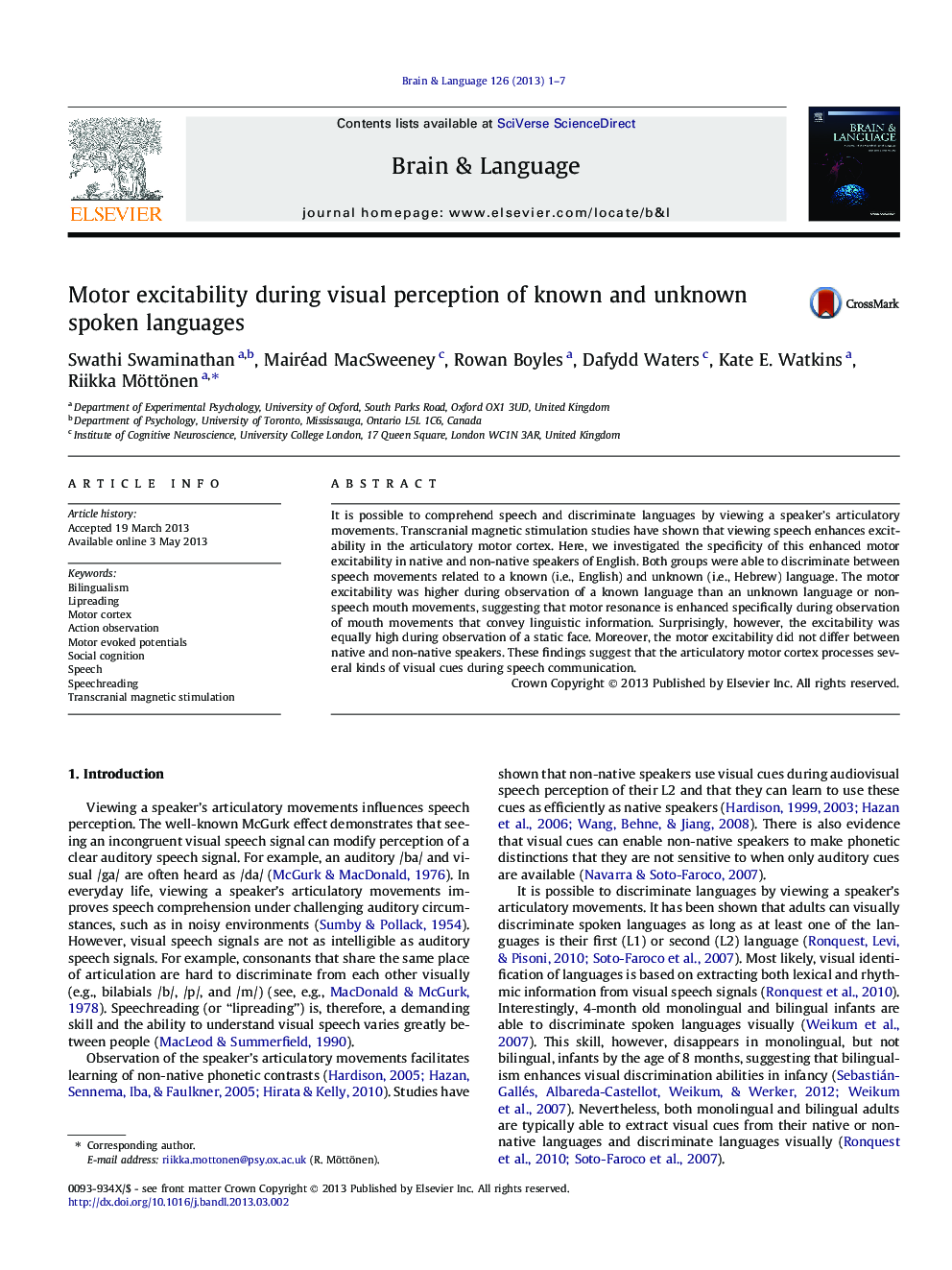| کد مقاله | کد نشریه | سال انتشار | مقاله انگلیسی | نسخه تمام متن |
|---|---|---|---|---|
| 10456480 | 921484 | 2013 | 7 صفحه PDF | دانلود رایگان |
عنوان انگلیسی مقاله ISI
Motor excitability during visual perception of known and unknown spoken languages
ترجمه فارسی عنوان
تحریک پذیری موتور در هنگام مشاهده بصری از زبان های گفتاری شناخته شده و ناشناخته
دانلود مقاله + سفارش ترجمه
دانلود مقاله ISI انگلیسی
رایگان برای ایرانیان
کلمات کلیدی
ترجمه چکیده
با مشاهده یک حرکات مفصل سخنران، ممکن است گفتار را درک کنید و زبان را تبعیض کنید. مطالعات تحریک مغناطیسی مغناطیسی نشان داده است که مشاهده گفتار باعث افزایش تحریک پذیری در قشر حرکت مفصلی می شود. در اینجا، ما ویژگی خاص این تحریک پذیری موتور را در زبان مادری و غیر زبان مادری انگلیسی بررسی کردیم. هر دو گروه قادر به تشخیص بین حرکات گفتاری مربوط به یک زبان شناخته شده (به عنوان مثال، انگلیسی) و ناشناخته (یعنی زبان عبری) بودند. تحرک پذیری موتور در طی مشاهده یک زبان شناخته شده بالاتر از حرکات ناشناخته زبان و یا غیر سخن گفتن است که نشان می دهد که رزونانس حرکتی به طور خاص در هنگام مشاهده حرکات دهان که اطلاعات زبانی را انتقال می دهند افزایش یافته است. با این حال، به طرز شگفتانگیزی، در طول مشاهده یک چهره ثابت، تحریک پذیری به همان اندازه بالا بود. علاوه بر این، تحریک پذیری موتور بین زبان های بومی و غیر بومی تفاوت نداشت. این یافته ها نشان می دهد که قشر حرکتی مفصلی چندین نوع نشانه های بصری را در طول ارتباطات گفتاری پردازش می کند.
موضوعات مرتبط
علوم زیستی و بیوفناوری
علم عصب شناسی
روانپزشکی بیولوژیکی
چکیده انگلیسی
It is possible to comprehend speech and discriminate languages by viewing a speaker's articulatory movements. Transcranial magnetic stimulation studies have shown that viewing speech enhances excitability in the articulatory motor cortex. Here, we investigated the specificity of this enhanced motor excitability in native and non-native speakers of English. Both groups were able to discriminate between speech movements related to a known (i.e., English) and unknown (i.e., Hebrew) language. The motor excitability was higher during observation of a known language than an unknown language or non-speech mouth movements, suggesting that motor resonance is enhanced specifically during observation of mouth movements that convey linguistic information. Surprisingly, however, the excitability was equally high during observation of a static face. Moreover, the motor excitability did not differ between native and non-native speakers. These findings suggest that the articulatory motor cortex processes several kinds of visual cues during speech communication.
ناشر
Database: Elsevier - ScienceDirect (ساینس دایرکت)
Journal: Brain and Language - Volume 126, Issue 1, July 2013, Pages 1-7
Journal: Brain and Language - Volume 126, Issue 1, July 2013, Pages 1-7
نویسندگان
Swathi Swaminathan, Mairéad MacSweeney, Rowan Boyles, Dafydd Waters, Kate E. Watkins, Riikka Möttönen,
